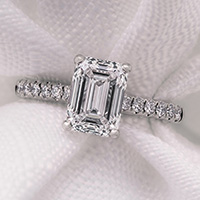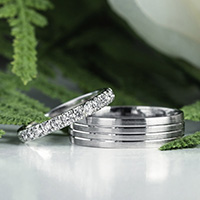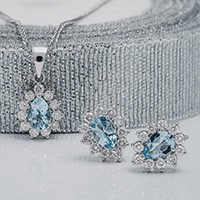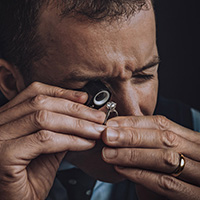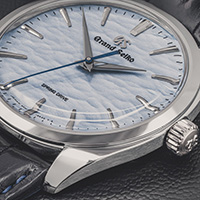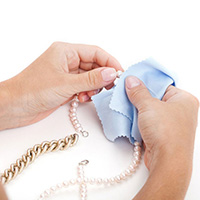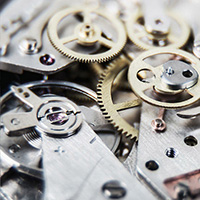Aquamarine: The March Birthstone
In cool shades of ocean-blue, Aquamarine is a serene gemstone with beautiful colour and clarity. It takes its name from the Latin aqua marinus - meaning ‘water of the sea’. Aquamarine is the birthstone for the month of March and is also the 19th anniversary gemstone.
A fantastic, affordable alternative to diamonds, Aquamarine gives off a lovely, bright sparkle. Its pale colouring also suits almost any complexion.
Properties of Aquamarine: Hardness and Colour
Aquamarine measures 7.5-8.5 on the Mohs scale. Its relative hardness and durability make it ideal for frequently worn jewellery such as rings. Its distinctive blue hue is due to the presence of iron during its formation. Colours range from pale blue to blue-green or teal with the darkest blue variants considered the most valuable. However, many people choose Aquamarine for the lightness of its tone.
Like Emerald, Aquamarine belongs to the Beryl mineral family. Unlike Emerald, Aquamarine is more frequently available and large crystals are common. It is also common to find aquamarine without any internal inclusions or imperfections. So, although they are from the same mineral family, it is very different to emeralds which are generally small and difficult to find without imperfections.
Not to be confused with Blue Topaz, Aquamarine commands a higher price.
Where and how is Aquamarine mined?
Most Aquamarine is mined in Brazil. The provinces of Minas Gerais, Espirito Santo and Bahia produce the finest gemstones. However, Aquamarine is also mined in Asia and Africa.
The Brazilian government restricts the mechanised mining of Aquamarine to protect indigenous people and the environment from exploitation. Consequently, Brazilian Aquamarine is ethically mined and conflict-free.
Aquamarine throughout History
The Romans believed that Poseidon, the God of the Sea, made Aquamarine from seawater. Similarly, they believed that amulets made from Aquamarine would protect them from storms at sea. In Medieval Europe, Aquamarine was cited as a cure for ailments such as tired eyes, toothache, sore throats, digestive problems and of course, sea sickness. It was also recognised as an antidote for poison. Egyptians considered Aquamarine a symbol of everlasting youth and happiness. Consequently, archaeologists have discovered Aquamarine in many Egyptian tombs.
Meaning and Symbolism
Aquamarine symbolises courage, friendship, and loyalty. Also, it is believed to promote calmness and peace. In a relationship, Aquamarine represents trust and harmony.
Indian spiritual thinkers believe that Aquamarine rules the throat chakra and helps people to speak clearly. This is no doubt linked to the ancient belief that it has the power to expose deceit or betrayal by changing colour. This reveals the true face of the wearer: a light colour represents honesty with a dark shade reflecting evil intent or anger.
Finally, there is also a widely held belief that Aquamarine can enhance feminine energy and empowerment if worn by women.
The Dom Pedro Aquamarine
The world’s largest cut Aquamarine is called the Dom Pedro Aquamarine and weighs 10,363 carats. Discovered in the 1980’s by miners in the Pedra Azul gem mine in Brazil, incredibly, it was originally three feet long and weighed nearly 100 pounds. Sadly, it was dropped by the miners and broke into three pieces. The two smallest pieces were broken up and used to make jewellery. However, the largest piece escaped this fate. It was named Dom Pedro, after the first emperor of Brazil in the 19th century.
In the 1990’s, German gem sculptor Bernd Munsteiner purchased the Dom Pedro Aquamarine. Over a six-month period, he cut it into an incredible obelisk. Creating facets to trap ambient light, his creation is called Ondas Maritimas (“Waves of the Sea”). It is currently on display in the Smithsonian National Museum of Natural History in Washington D.C.
Aquamarine: Links to Royalty
The British, Dutch, and Danish crown jewellery all include Aquamarine.
The late Diana, Princess of Wales, famously wore a stunning emerald-cut Aquamarine cocktail ring. Known as “the divorce ring”, in 1996 she wore it to replace her sapphire and diamond engagement ring. The stone was given to her by her friend, Lucia Flecha de Lima, perhaps due to the symbolism and association with friendship. Asprey was commissioned to incorporate the stone into a ring, and Diana wore it to several glamorous events. The ring was later bequeathed to Prince Harry and given as a gift to Meghan who wore it at their Frogmore House wedding reception in 2018.
The Queen also has a number of aquamarine pieces in her collection, including a striking pair of Boucheron clip brooches. The brooches were given to her in 1944 by her father, King George VI to celebrate her 18th birthday. Art Deco in style, the brooches contain baguette diamonds and Aquamarine. She has worn the brooches on many occasions but most notably for her televised TV broadcast in 2020 to mark the 75th Anniversary of VE Day.
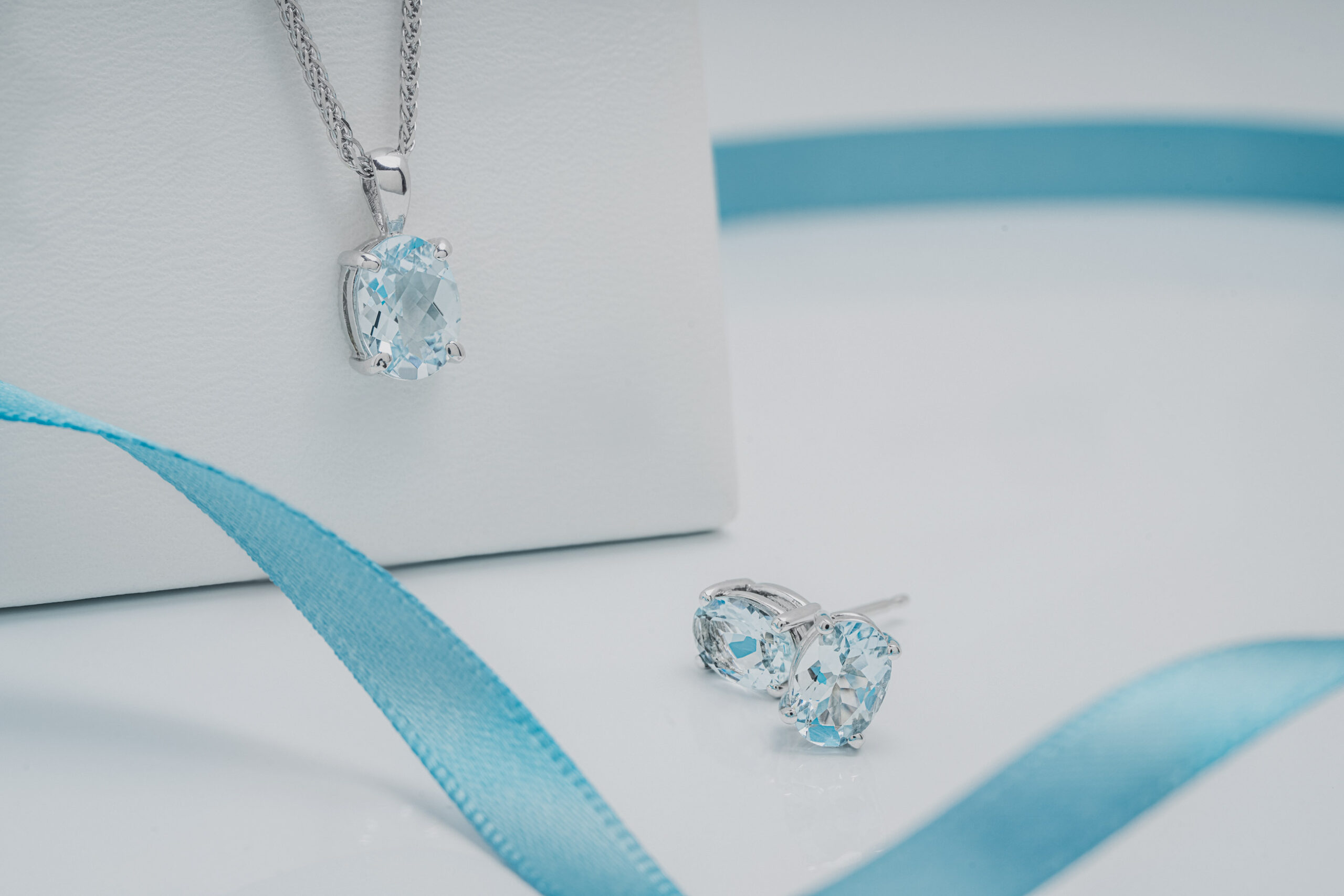
9ct white gold Aquamarine stud earrings and pendant.
Guide to Buying Aquamarine: How is it graded?
The 4 C’s
The ‘4 C’s’ (cut, colour, clarity, and carat) are used to grade Aquamarine (in the same way diamonds are graded).
Cut
Aquamarine can be cut into almost any shape. The cut determines its shape and how much it sparkles. Due to its hardness and colour, Aquamarine is most commonly cut into rectangular emerald cuts or oval shapes which bring out the natural colour and sparkle of the stone. Round cuts are also popular as well as pear, heart, and other fancy shapes.
Colour
Ranging from light blue to green-blue, darker gems with a saturated blue colour are the most sought-after. However, watch-out because most dark aquamarines are heat-treated. High temperatures of approx. 400 °Celsius remove the green hue. Naturally blue stones fetch a higher price than heat-treated ones. Also, look out for even colour. There should be no lighter or darker patches of colour.
Clarity
It should not be possible to see imperfections (inclusions) with the naked eye. Although some Aquamarine gemstones can contain liquid inclusions that look like tiny bubbles, it is not usually possible to see these without a jeweller’s loupe.
Carat
The per carat value of Aquamarine does not increase incrementally as with other gemstones. Consequently, large gemstones represent great value for money. However, don’t go too large! Since it is available in a variety of sizes from small to extremely large crystals, it’s hard to incorporate large stones into jewellery. Therefore, there is less demand for Aquamarine over 25 carats.
Categories
Based on the 4 C’s above, an Aquamarine can be classified into one of four categories. If you have ever watched the BBC’s Antiques Roadshow, you will be familiar with their brilliant ‘Basic, Better & Best’ challenge. Aquamarine can be classified in similar terms:-
Good (A) – Very light sea-blue colour with slight to moderate inclusions. The top 75% of all Aquamarine falls into this category
Better (AA) – Light sea-blue colour with slight inclusions
Best (AAA) – Medium sea-blue colour, clean to the naked eye and brilliant. The top 10% of all available Aquamarine
Heirloom (AAAA) – Medium sea-blue colour, no visible inclusions, high brilliance. The top 1% of Aquamarine and therefore extremely rare
How to Care for Aquamarine: Tips and Handy Hints
Aquamarine is a durable gemstone, but it still requires care and maintenance to keep it looking its best.
- Remove Aquamarine rings when doing housework, gardening, swimming or any physical activity
- Store Aquamarine jewellery in a separate pouch away from harder gemstones such as diamonds which can cause scratches
- Prolonged exposure to sunlight may affect the colour so store in a fabric-lined box in the dark.
- Avoid exposure to chemicals such as ammonia, chlorine etc
- Gently clean using warm, soapy water and a soft brush. Rinse clean
Aquamarine at James Porter & Son
Browse our collection of stunning Aquamarine jewellery online or visit one of our boutiques in Glasgow’s famous Argyll Arcade. Use it to add meaning, value, and interest to your jewellery collection, especially if it’s your birthstone.
If you’re getting married, Aquamarine jewellery is perfect as your “something blue”. Also, complemented by diamonds and with a robust setting, it makes for a beautiful engagement ring.
If you have any questions about Aquamarine contact us here.
 Basket
Basket

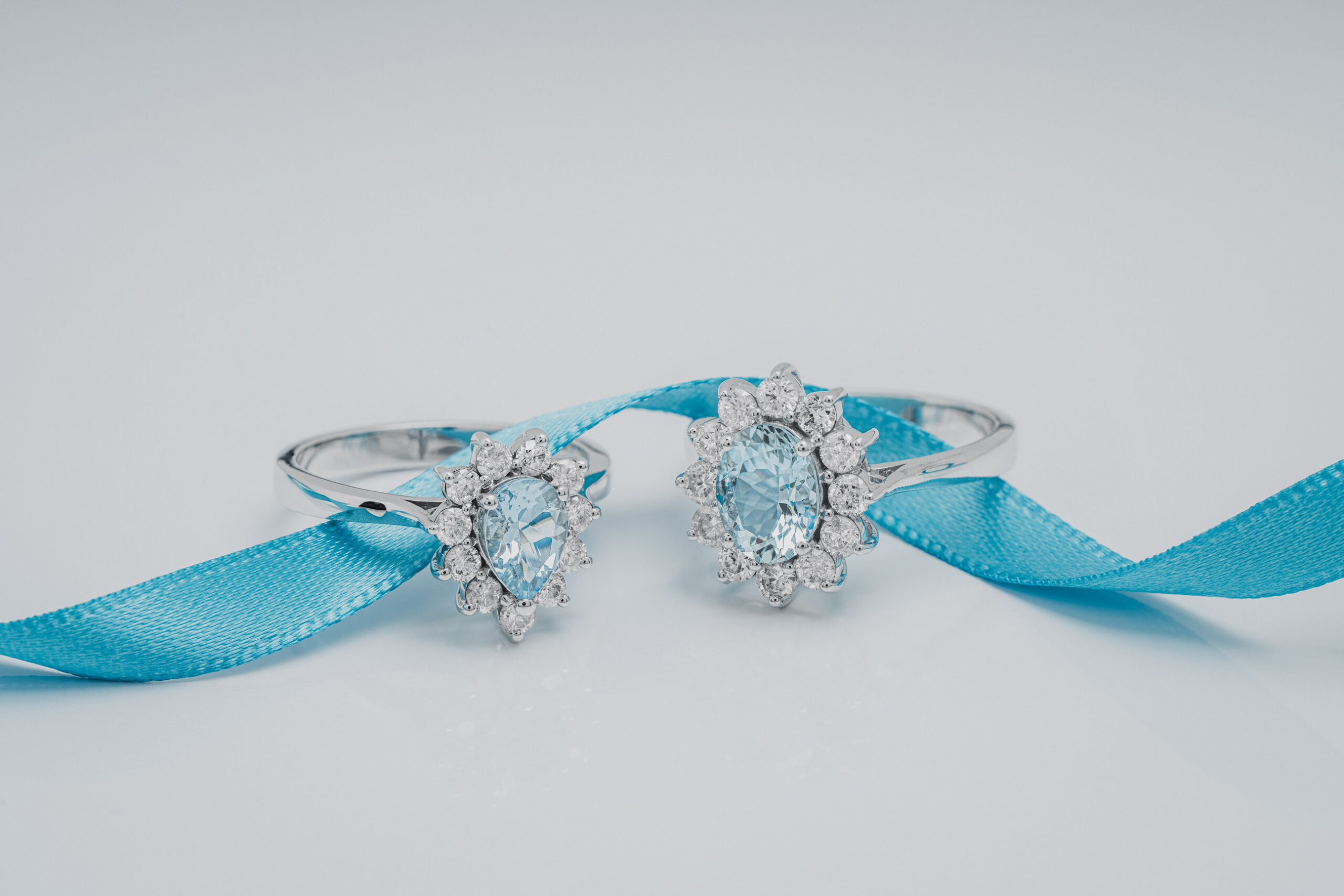
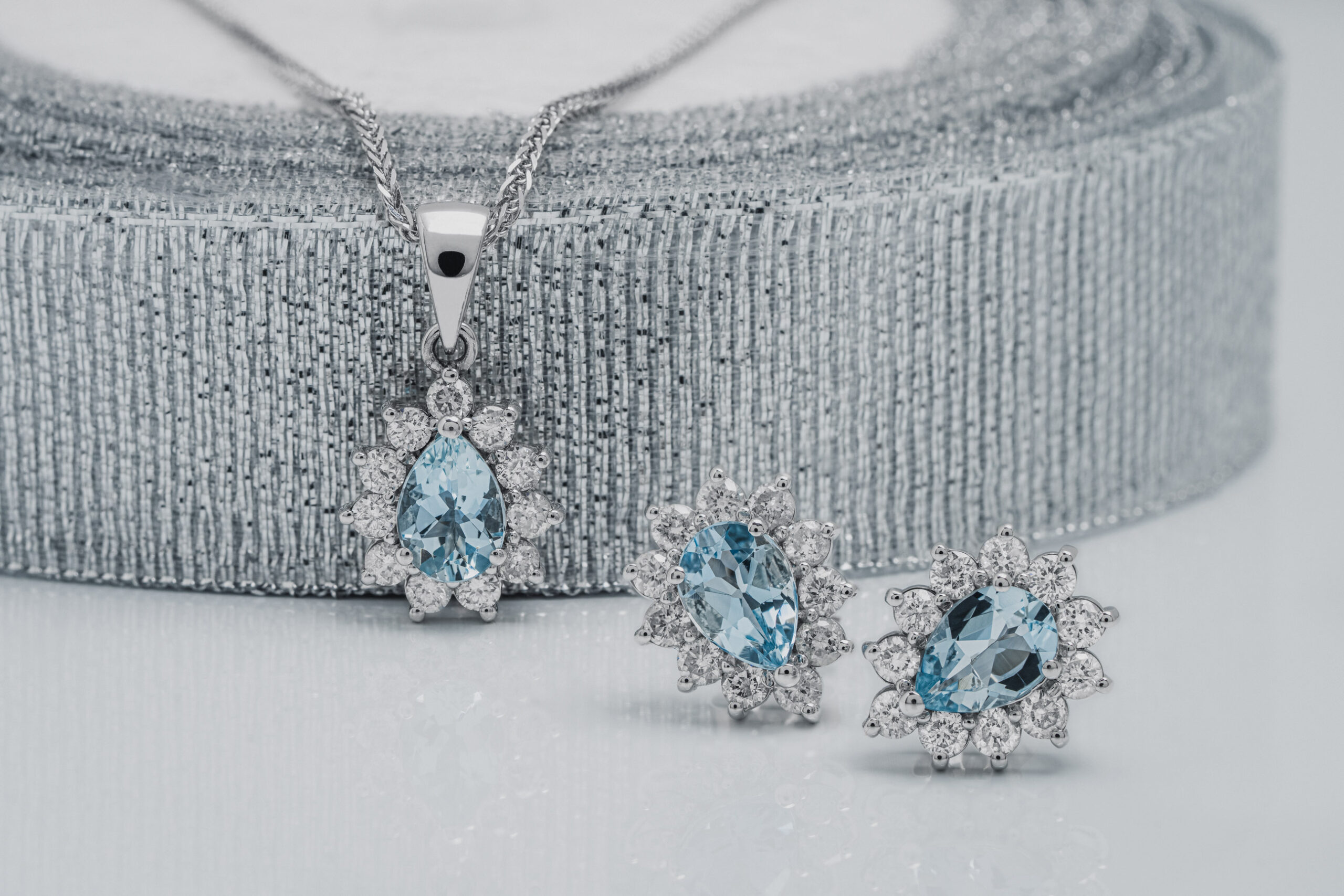




 Back to top
Back to top 0141 221 5855
0141 221 5855 Send us an email
Send us an email






 Secure payment methods
Secure payment methods


